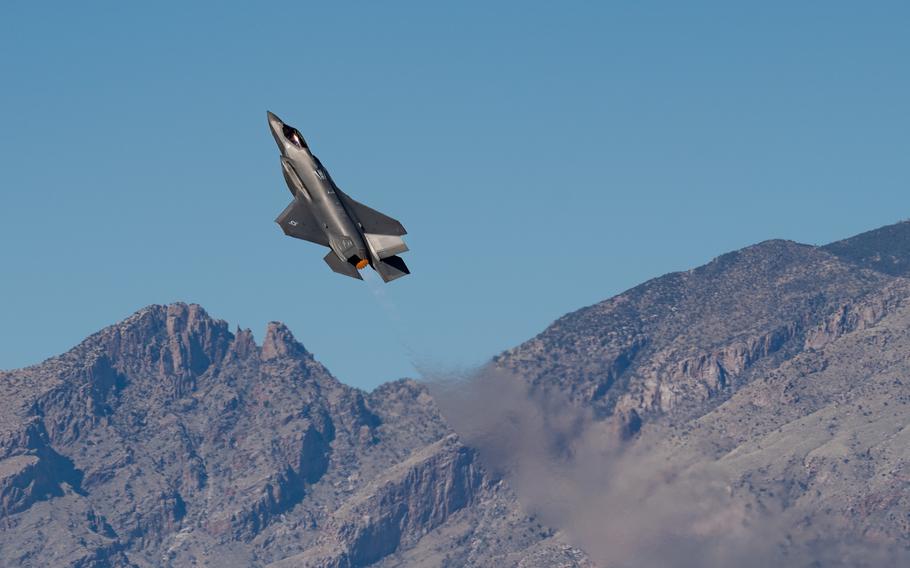
An Air Force F-35 Lightning II flies over Davis-Monthan Air Force Base, Ariz., on March 4, 2023. The F-35A Lightning II Demonstration Team is part of the first operational F-35A wing for the Air Force, the 388th Fighter Wing, and flies demonstrations at air shows around the world. (Jhade Herrera/U.S. Air Force)
Air Force leaders said Monday that they plan to buy 96 aircraft, including 72 fighter jets, and boost their research into future technologies by nearly 10% as part of the service’s more than $185 billion budget proposal for fiscal 2024.
The spending plan for the fiscal year that starts Oct. 1 is about $5.4 billion more than the budget for 2023. Air Force Secretary Frank Kendall said the plan is a “beautiful balance” between operational demands now and modernizing to stay ahead of the future threats that are primarily coming from China’s ability to rapidly update its military’s technology. It’s just part of the more than $215 billion budget request from Department of the Air Force, which includes $30 billion for Space Force.
“I'm very comfortable with what we're asking for. I think we've got a good mix here,” Kendall said Friday on a call with reporters.
The Air Force funding plan is part of the Defense Department budget proposal of $842 billion, which is up 3.2% from fiscal 2023, which ends Sept. 30. The $26 billion increase from last year’s spending would include a 5.2% salary bump for troops — the highest in 20 years.
The Air Force’s proposed budget speeds up planned purchases of aircraft, including 48 F-35A fighter jets and 24 F-15EX jets. The service also plans to retire 310 aircraft, including 32 F-22 Raptors, 57 F-16 Eagles, 48 MQ-9 Reapers, which are unmanned aircraft, and 42 A-10 Thunderbolt II, also known as the Warthog.
The Air Force also plans to retire 24 KC-10 tankers as it requests the purchase of 15 of its replacement aircraft, the KC-46.
The plan includes funding for 1.1 million flying hours.
The proposal calls for a 9.7% increase in research and development spending, including the formation of an experimental operations unit, said Maj. Gen. Michael A. Greiner, deputy assistant secretary of the Air Force for budget. It includes an increase in money for the intercontinental ballistic missile replacement, the Sentinel program, as the first of the new strategic bomber B-21 Raider is projected to take flight later this year, he said.
Other new technology programs with increased funding include the next generation of manned and unmanned combat aircrafts and test aircraft for the continued development of the Survivable Airborne Operations Center, which is sometimes called the “Doomsday” plane and is made to survive a nuclear blast.
The Air Force budget also calls for $42.1 billion to fund 512,100 members of the Air Force and Space Force, including Air National Guard and Reserve members.
There are about 504,475 troops now in the Air Force and Space Force, according to budget documents. The Air Force is authorized now to have about 250 additional troops. If the Air Force can fill all the positions it’s requesting in 2024, it could see about 7,625 more troops in its ranks.
The Air Force asked for $588 million for civilian personnel, which includes a 5.2% pay raise — the largest in 40 years, Greiner said.
To help with recruiting, the budget includes funding for increasing pilot retention bonuses from $35,000 to $50,000, and $45 million for initial recruiting bonuses.
The service is requesting $368 million that will go toward 39 dormitories, and another $731 million for infrastructure improvement for environmental sustainability, such as electric, water, pipeline and landscaping improvements.
The Air Force requested $3.8 billion for 49 projects in 17 states and overseas locations for military construction.
Kendall said it’s important that Congress pass this budget on schedule.
“So many people have been asking me about going faster and accelerating change … and how to make acquisition move faster. We move at the pace of money and engineering. And you don't start until you get the money,” he said.